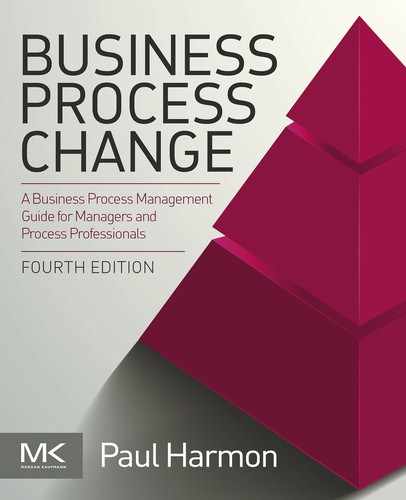Process analysis diagrams used in this book
In this appendix we provide a list of the diagrams in the book that students might draw or create using business process management software tools in the course of analyzing how a business process works. They are listed in the order in which they are introduced in the book.
Simple process diagram pp. 2, 180, 188, 346
Simple organization chart pp. 56, 129
Organization diagram pp. 62, 66, 155 (Created by Geary Rummler, who called it a supersystem diagram or a relationship map.)
Simple process architecture pp. 80, 89, 100, 165, 345
Scope diagram pp. 190, 192, 194, 197, 198, 204, 268, 349, 351, 358, 377 (Derived originally from integrated definition, or IDEF, methodology and termed an IDEF0 diagram it was extended to its present form by Roger Burlton, who termed it an IGOE diagram. It has been extended further by BPTrends to become a scope diagram.)
Cause-effect diagram pp. 191, 302, 350 (Also called a fishbone diagram or an Ishikawa diagram.)
BPMN process flow diagram pp. 210, 211, 215, 217, 218, 219, 220, 222, 224, 242, 243, 248, 270, 352, 353, 357, 358, 361, 363, 377, 400, 405 (Created by Geary Rummler, and often called a Rummler-Brache diagram, it shows a process flow diagram with the activities divided into swimlanes, labeled to show who is responsible for each swimlane. Traditionally, a customer swimlane is added at the top. Note that the customer could be another business process. IBM used Rummler-Brache diagrams for a while and called them LOVEM diagrams. This diagram has now been formalized by the Object Management Group and is a diagram used in their Business Process Model and Notation, or BPMN.)
CMMN process diagram p. 227 (An Object Management Group Case Management Model and Notation, or CMMN, diagram used to show a group of activities within dynamic processes that are loosely connected.)
DMM decision diagram p. 252 (An Object Management Group Decision Management Model, or DMM, diagram used to show how groups of business rules are related to specific processes in which decisions are made.)
SIPOC diagram p. 293 (A simple process diagram often used in Six Sigma projects. Stands for Suppliers-Inputs-Process-Outputs-Customer.)
Value stream map p. 307 (A circular flow diagram of a process that begins with a customer request and ends with the delivery of whatever the customer requested. Commonly used by Lean practitioners.)
Stakeholder diagram p. 347 (Extension of a simple process diagram designed to show the stakeholders of a process.)
BPMN/use case diagram p. 364 (Use case diagrams were originated by Ivar Jacobson in conjunction with object-oriented analysis, and later formalized by the Object Management Group. The diagrams show how software will be used by those using it. We have extended it to fit within a Business Process Model and Notation, or BPMN, process flow diagram to allow process analysts to identify and define where software applications could be used in a business process.)
Process relationship diagram (Extension of a simple process diagram that shows other core, management, and support processes that interface with the process-in-scope.)
